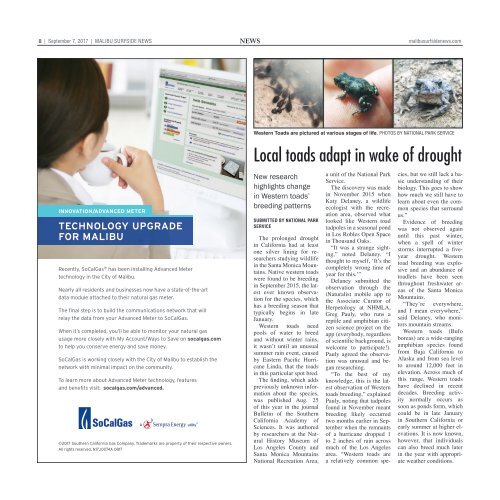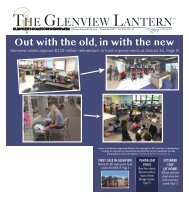MSN_090717
Malibu Surfside News 090717
Malibu Surfside News 090717
Create successful ePaper yourself
Turn your PDF publications into a flip-book with our unique Google optimized e-Paper software.
8 | September 7, 2017 | Malibu surfside news News<br />
malibusurfsidenews.com<br />
INNOVATION/ADVANCED METER<br />
TECHNOLOGY UPGRADE<br />
FOR MALIBU<br />
Recently, SoCalGas ® has been installing Advanced Meter<br />
technology in the City of Malibu.<br />
Nearly all residents and businesses now have a state-of-the-art<br />
data module attached to their natural gas meter.<br />
The final step is to build the communications network that will<br />
relay the data from your Advanced Meter to SoCalGas.<br />
When it’s completed, you’ll be able to monitor your natural gas<br />
usage more closely with My Account/Ways to Save on socalgas.com<br />
to help you conserve energy and save money.<br />
SoCalGas is working closely with the City of Malibu to establish the<br />
network with minimal impact on the community.<br />
To learn more about Advanced Meter technology, features<br />
and benefits visit: socalgas.com/advanced.<br />
©2017 Southern California Gas Company. Trademarks are property of their respective owners.<br />
All rights reserved. N17J0074A 0817<br />
Western Toads are pictured at various stages of life. Photos by National Park Service<br />
Local toads adapt in wake of drought<br />
New research<br />
highlights change<br />
in Western toads’<br />
breeding patterns<br />
Submitted by National Park<br />
Service<br />
The prolonged drought<br />
in California had at least<br />
one silver lining for researchers<br />
studying wildlife<br />
in the Santa Monica Mountains.<br />
Native western toads<br />
were found to be breeding<br />
in September 2015, the latest<br />
ever known observation<br />
for the species, which<br />
has a breeding season that<br />
typically begins in late<br />
January.<br />
Western toads need<br />
pools of water to breed<br />
and without winter rains,<br />
it wasn’t until an unusual<br />
summer rain event, caused<br />
by Eastern Pacific Hurricane<br />
Linda, that the toads<br />
in this particular spot bred.<br />
The finding, which adds<br />
previously unknown information<br />
about the species,<br />
was published Aug. 25<br />
of this year in the journal<br />
Bulletin of the Southern<br />
California Academy of<br />
Sciences. It was authored<br />
by researchers at the Natural<br />
History Museum of<br />
Los Angeles County and<br />
Santa Monica Mountains<br />
National Recreation Area,<br />
a unit of the National Park<br />
Service.<br />
The discovery was made<br />
in November 2015 when<br />
Katy Delaney, a wildlife<br />
ecologist with the recreation<br />
area, observed what<br />
looked like Western toad<br />
tadpoles in a seasonal pond<br />
in Los Robles Open Space<br />
in Thousand Oaks.<br />
“It was a strange sighting,”<br />
noted Delaney. “I<br />
thought to myself, ‘It’s the<br />
completely wrong time of<br />
year for this.’”<br />
Delaney submitted the<br />
observation through the<br />
iNaturalist mobile app to<br />
the Associate Curator of<br />
Herpetology at NHMLA,<br />
Greg Pauly, who runs a<br />
reptile and amphibian citizen<br />
science project on the<br />
app (everybody, regardless<br />
of scientific background, is<br />
welcome to participate!).<br />
Pauly agreed the observation<br />
was unusual and began<br />
researching.<br />
“To the best of my<br />
knowledge, this is the latest<br />
observation of Western<br />
toads breeding,” explained<br />
Pauly, noting that tadpoles<br />
found in November meant<br />
breeding likely occurred<br />
two months earlier in September<br />
when the remnants<br />
of a hurricane dropped 1<br />
to 2 inches of rain across<br />
much of the Los Angeles<br />
area. “Western toads are<br />
a relatively common species,<br />
but we still lack a basic<br />
understanding of their<br />
biology. This goes to show<br />
how much we still have to<br />
learn about even the common<br />
species that surround<br />
us.”<br />
Evidence of breeding<br />
was not observed again<br />
until this past winter,<br />
when a spell of winter<br />
storms interrupted a fiveyear<br />
drought. Western<br />
toad breeding was explosive<br />
and an abundance of<br />
toadlets have been seen<br />
throughout freshwater areas<br />
of the Santa Monica<br />
Mountains.<br />
“They’re everywhere,<br />
and I mean everywhere,”<br />
said Delaney, who monitors<br />
mountain streams.<br />
Western toads (Bufo<br />
boreas) are a wide-ranging<br />
amphibian species found<br />
from Baja California to<br />
Alaska and from sea level<br />
to around 12,000 feet in<br />
elevation. Across much of<br />
this range, Western toads<br />
have declined in recent<br />
decades. Breeding activity<br />
normally occurs as<br />
soon as ponds form, which<br />
could be in late January<br />
in Southern California or<br />
early summer at higher elevations.<br />
It is now known,<br />
however, that individuals<br />
can also breed much later<br />
in the year with appropriate<br />
weather conditions.


















